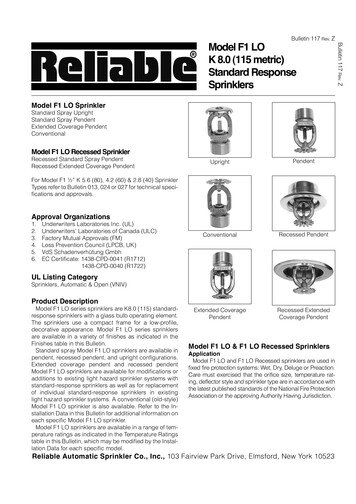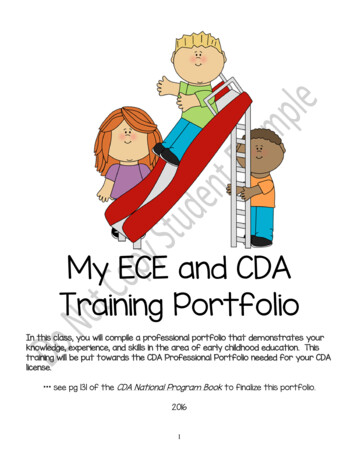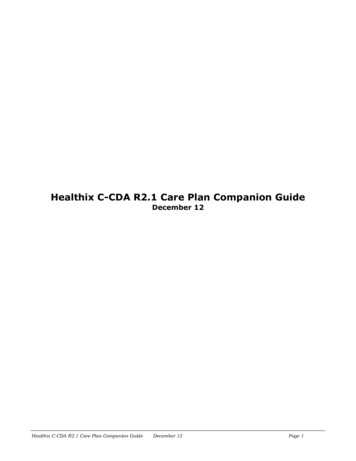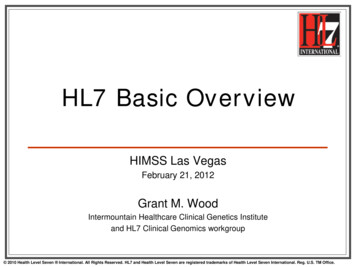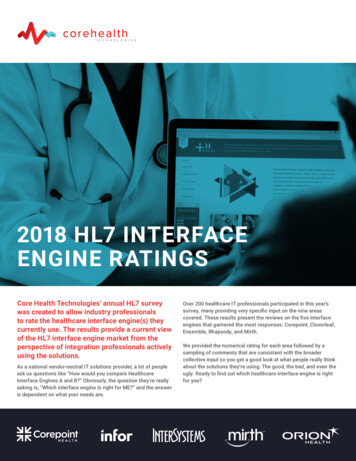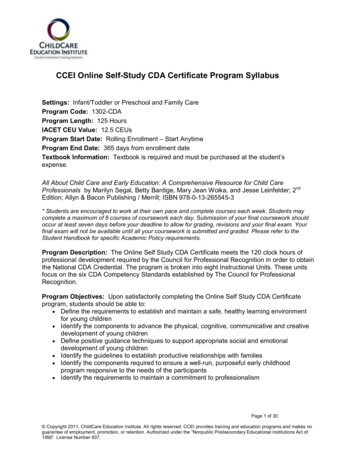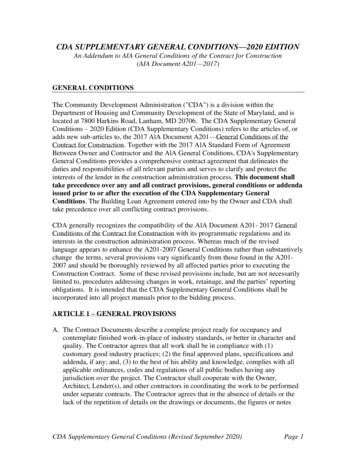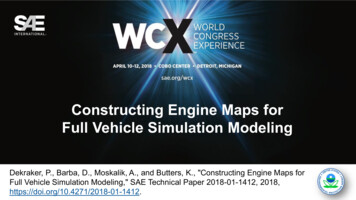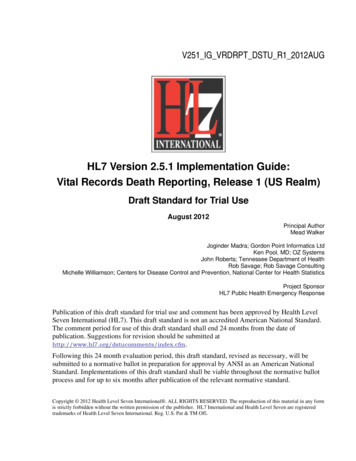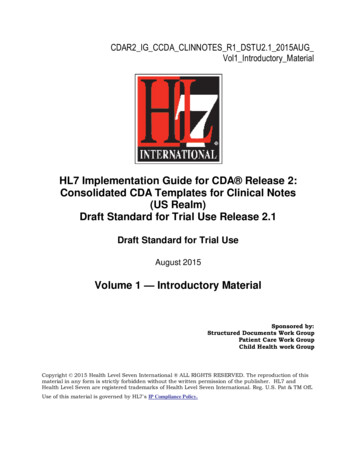
Transcription
CDAR2 IG CCDA CLINNOTES R1 DSTU2.1 2015AUGVol1 Introductory MaterialHL7 Implementation Guide for CDA Release 2:Consolidated CDA Templates for Clinical Notes(US Realm)Draft Standard for Trial Use Release 2.1Draft Standard for Trial UseAugust 2015Volume 1 — Introductory MaterialSponsored by:Structured Documents Work GroupPatient Care Work GroupChild Health work GroupCopyright 2015 Health Level Seven International ALL RIGHTS RESERVED. The reproduction of thismaterial in any form is strictly forbidden without the written permission of the publisher. HL7 andHealth Level Seven are registered trademarks of Health Level Seven International. Reg. U.S. Pat & TM Off.Use of this material is governed by HL7's IP Compliance Policy.
IMPORTANT NOTES:HL7 licenses its standards and select IP free of charge. If you did not acquire a free license from HL7 for thisdocument, you are not authorized to access or make any use of it. To obtain a free license, please cfm.If you are the individual that obtained the license for this HL7 Standard, specification or other freelylicensed work (in each and every instance "Specified Material"), the following describes the permitted usesof the Material.A. HL7 INDIVIDUAL, STUDENT AND HEALTH PROFESSIONAL MEMBERS, who register and agree to theterms of HL7’s license, are authorized, without additional charge, to read, and to use Specified Material to developand sell products and services that implement, but do not directly incorporate, the Specified Material in whole or inpart without paying license fees to HL7.INDIVIDUAL, STUDENT AND HEALTH PROFESSIONAL MEMBERS wishing to incorporate additional items of SpecialMaterial in whole or part, into products and services, or to enjoy additional authorizations granted to HL7ORGANIZATIONAL MEMBERS as noted below, must become ORGANIZATIONAL MEMBERS of HL7.B. HL7 ORGANIZATION MEMBERS, who register and agree to the terms of HL7's License, are authorized, withoutadditional charge, on a perpetual (except as provided for in the full license terms governing the Material), nonexclusive and worldwide basis, the right to (a) download, copy (for internal purposes only) and share this Materialwith your employees and consultants for study purposes, and (b) utilize the Material for the purpose of developing,making, having made, using, marketing, importing, offering to sell or license, and selling or licensing, and tootherwise distribute, Compliant Products, in all cases subject to the conditions set forth in this Agreement and anyrelevant patent and other intellectual property rights of third parties (which may include members of HL7). No otherlicense, sublicense, or other rights of any kind are granted under this Agreement.C. NON-MEMBERS, who register and agree to the terms of HL7’s IP policy for Specified Material, are authorized,without additional charge, to read and use the Specified Material for evaluating whether to implement, or inimplementing, the Specified Material, and to use Specified Material to develop and sell products and services thatimplement, but do not directly incorporate, the Specified Material in whole or in part.NON-MEMBERS wishing to incorporate additional items of Specified Material in whole or part, into products andservices, or to enjoy the additional authorizations granted to HL7 ORGANIZATIONAL MEMBERS, as noted above,must become ORGANIZATIONAL MEMBERS of HL7.Please see http://www.HL7.org/legal/ippolicy.cfm for the full license terms governing the Material.Ownership. Licensee agrees and acknowledges that HL7 owns all right, title, and interest, in and to the Materials.Licensee shall take no action contrary to, or inconsistent with, the foregoing.Licensee agrees and acknowledges that HL7 may not own all right, title, and interest, in and to the Materialsand that the Materials may contain and/or reference intellectual property owned by third parties (“Third PartyIP”). Acceptance of these License Terms does not grant Licensee any rights with respect to Third Party IP.Licensee alone is responsible for identifying and obtaining any necessary licenses or authorizations toutilize Third Party IP in connection with the Materials or otherwise. Any actions, claims or suits brought by athird party resulting from a breach of any Third Party IP right by the Licensee remains the Licensee’s liability.Following is a non-exhaustive list of third-party terminologies that may require a separate license:TerminologyOwner/ContactCurrent Procedures Terminology(CPT) code setSNOMED CTLogical Observation IdentifiersNames & Codes (LOINC)International Classification ofDiseases (ICD) codesAmerican Medical ing.page?International Healthcare Terminology StandardsDeveloping Organization -ct orinfo@ihtsdo.orgRegenstrief InstituteWorld Health Organization (WHO)HL7 CDA R2 IG: Consolidated CDA Templates for Clinical Note (US Realm), DSTU R2.1—Vol. 1: IntroPage 2August 2015 2015 Health Level Seven, Inc. All rights reserved.
Structure of This GuideTwo volumes comprise this HL7 Implementation Guide for CDA Release 2: ConsolidatedCDA Templates for Clinical Notes. Volume 1 provides narrative introductory andbackground material pertinent to this implementation guide, including information onhow to understand and use the templates in Volume 2. Volume 2 contains thenormative Clinical Document Architecture (CDA) templates for this guide along withlists of all templates, code systems, value sets, and changes from the previous version.HL7 CDA R2 IG: Consolidated CDA Templates for Clinical Note (US Realm), DSTU R2.1—Vol. 1: IntroPage 3August 2015 2015 Health Level Seven, Inc. All rights reserved.
PrimaryEditor /Co-ChairRick GeimerLantana Consulting Grouprick.geimer@lantanagroup.comCoEditor:Benjamin FlessnerEpicBenjamin@epic.comPrimaryEditor /Co-Chair:Brett MarquardRiver Rock rry Garber, MDReliant Medical ir:Calvin BeebeMayo Cliniccbeebe@mayo.eduCoEditor:Jennie Harvell, M.EdUS Health and Human ServicesJennie.harvell@hhs.govCo-Chair:Diana BehlingIatric SystemsDiana.Behling@iatric.comCoEditor:Laura Heermann Langford, RN, PhDIntermountain HealthcareLaura.Heermann@imail.orgCo-Chair:Austin KreislerSAIC Consultant to CDC/NHSNduz1@cdc.govCoEditor:Emma Jones RN-BC, rick LloydIcode ditor /Co-ChairGaye Dolin, MSN, RNIntelligent Medical Objects, Inc.gdolin@imo-online.comCoEditor:Josh Mandel, MDHarvard Medical School / BostonChildren's HospitalJoshua.Mandel@childrens.harvard.eduSusan Matney, MSN, RN3M Health Information Systemssamatney@mmm.comPrimaryEditor:Sarah GauntLantana Consulting Groupsarah.gaunt@lantanagroup.comCoEditor:Sean McIlvennaLantana Consulting Zabrina GonzagaLantana Consulting itor:Liora AlschulerLantana Consulting Groupliora.alschuler@lantanagroup.comCoEditor:Dale NelsonLantana Consulting Groupdale.nelson@lantanagroup.comLisa NelsonLife Over Time SolutionsLisaRNelson@cox.netCoEditor:Virinder BatraIntuit Healthvirinder.batra@gmail.comCoEditor:Terrence A. O'Malley, MDPartners Healthcaretomalley@partners.orgCoEditor:Keith W. BooneGE Healthcarekeith.boone@ge.comCoEditor:Eric ParapiniLantana Consulting n Chu, MD, PhD, FACSNational E-Health or:David Tao, D.Sc.ICSA Labsdtao12@gmail.comCoEditor:John D'AmoreLantana Consulting drienne GiannoneLantana Consulting bert H. Dolin, MDbobdolin@gmail.comTechnicalEditor:Diana WrightLantana Consulting Groupdiana.wright@lantanagroup.comCoEditor:Susan Campbell, PhD, onica KwokDeloittevkwok@deloitte.comHL7 CDA R2 IG: Consolidated CDA Templates for Clinical Note (US Realm), DSTU R2.1—Vol. 1: IntroPage 4August 2015 2015 Health Level Seven, Inc. All rights reserved.
Current Work Group includes those who participated in the Structured Documents C-CDA DSTURelease 2.1 project: Elaine Ayres, Calvin Beebe, Diana Behling, Keith Boone, Chris Brown, George Cole,John D’Amore, Gay Dolin, Benjamin Flessner, Evelyn Gallego, Rob Hausam, Lindsay Hoggle, AustinKreisler, Vinayak Kulkrni, Veronica Kwok, Russ Leftwich, Chethan Makonahalli, Brett Marquard, LisaNelson, Lauren Niles, M’Lynda Owens, Ann Phillips, Mark Pilley, Donna Quirk, Matthew Rahn, MarkRoche, Andrew Satler, Brian Scheller, Julia Skapik, Anne Marie Smith, Corey Spears, David SundaramStukel, David TaoPrior Work Group for C-CDA Release 2.0 includes all those who participated in the ONC S&IFramework: Maria Abraham, Kunal Agarwal, Elaine Ayres, Rich Brennan, Robin Bronson, PaulBurnstein, Matt Cairns, Christina Caraballo, Robert Dieterle, Margaret Dittloff, Rob Flessner, HarrisonFox, Jackie Friedman, Bob Habasevich, Beth Halley, Kate Hamilton, Naomi Harter, Lindsey Hoggle,Lester Keepper, Leslie Kelly Hall, Jack Kemery, Rosemary Kennedy, Nora Kershaw, Emilie Kralicek,Russ Leftwich, Cynthia Levy, Paul Lomayesva, Joanne Lynn, Enrique Meneses, Joe Miller, Holly Miller,Liz Milton, Sue Mitchell, Maria Moen, Alice Moore, Teresa Mota, Nancy Munoz, Gordon Raup, DanRoman, Bill Russell, Caroline Silzle, Kathryn Sorte, Mary St Pierre, Teresa Strickland, Joann Susser,Jim Thompson, Iona Thraen, Cyndalynn Tilley, Rita Torkzadeh, Mike Tushan, Lee Unangst, SerafinaVersaggi, Kate Wetherby, Grace Whiting, Oleg Yavorsky, Bonnie Yingling.HL7 CDA R2 IG: Consolidated CDA Templates for Clinical Note (US Realm), DSTU R2.1—Vol. 1: IntroPage 5August 2015 2015 Health Level Seven, Inc. All rights reserved.
AcknowledgmentsThis R2.1 guide was developed and produced through the efforts of Health Level Seven(HL7).The editors appreciate the support and sponsorship of the HL7 Structured DocumentsWorking Group (SDWG), the HL7 Patient Care Work Group, the HL7 Child Health WorkGroup, and all volunteers and staff associated with the creation of this document. Thisguide would not have been possible without the support of the Department ofDefense/Department of Veterans Affairs Interagency Program Office (DoD/VA IPO).This material contains content from SNOMED CT (http://www.ihtsdo.org/snomedct/). SNOMED CT is a registered trademark of the International Health TerminologyStandard Development Organisation (IHTSDO).This material contains content from the Logical Observation Identifiers Names andCodes (LOINC) organization (http://loinc.org). The LOINC table, LOINC codes, andLOINC panels and forms file are copyright 1995-2014, Regenstrief Institute, Inc. andLOINC Committee, and available at no cost under the license at http://loinc.org/termsof-use.HL7 CDA R2 IG: Consolidated CDA Templates for Clinical Note (US Realm), DSTU R2.1—Vol. 1: IntroPage 6August 2015 2015 Health Level Seven, Inc. All rights reserved.
Contents1INTRODUCTION. 111.1Purpose . 111.2Audience . 121.3Organization of the Guide . 121.3.1Volume 1 Introductory Material . 121.3.2Volume 2 CDA Templates and Supporting Material . 121.42Contents of the Package. 13CDA R2 BACKGROUND . 142.1Templated CDA . 142.1.12.23Current Project . 16DESIGN CONSIDERATIONS . 183.14Status of a Template Version . 15Compatibility . 183.1.1Support for specifications with dependencies on C-CDA Release 2.0 . 193.1.2Assertion of Compatibility . 193.2CDA Participations . 203.3Determining the Status of Clinical Statement . 213.4Rendering Header Information for Human Presentation . 243.5Narrative Reference . 243.6Unknown and No Known Information. 25USING THIS IMPLEMENTATION GUIDE . 304.1Levels of Constraint . 304.2Conformance Conventions Used in This Guide . 304.2.1Templates and Conformance Statements . 304.2.2Template Versioning . 324.2.3Open and Closed Templates. 334.2.4Conformance Verbs (Keywords) . 334.2.5Cardinality . 344.2.6Optional and Required with Cardinality . 354.2.7Containment Relationships . 354.2.8Vocabulary Conformance . 364.2.9Data Types . 384.2.10Document-Level Templates "Properties" Heading . 38HL7 CDA R2 IG: Consolidated CDA Templates for Clinical Note (US Realm), DSTU R2.1—Vol. 1: IntroPage 7August 2015 2015 Health Level Seven, Inc. All rights reserved.
4.35XML Conventions Used in This Guide . 384.3.1XPath Notation . 384.3.2XML Examples and Sample Documents . 39REFERENCES. 40APPENDIX A —ACRONYMS AND ABBREVIATIONS . 43APPENDIX B —HIGH-LEVEL CHANGE LOG . 47Volume 1 Summary of Changes . 47Volume 2 Summary of Changes . 48APPENDIX C —EXTENSIONS TO CDA R2 . 54APPENDIX D —MIME MULTIPART/RELATED MESSAGES . 56MIME Multipart/Related Messages . 56RFC-2557 MIME Encapsulation of Aggregate Documents, Such as HTML (MHTML). 56Referencing Supporting Files in Multipart/Related Messages . 56Referencing Documents from Other Multiparts within the Same X12 Transactions . 57APPENDIX E —CARE PLAN RELATIONSHIPS . 58Care Plan Relationships and HL7 RIM Terms . 58Care Plan Relationships Story Board Example . 59APPENDIX F —FORMATSUNIQUE DEVICE IDENTIFICATION (UDI) ISSUING AGENCY61HL7 CDA R2 IG: Consolidated CDA Templates for Clinical Note (US Realm), DSTU R2.1—Vol. 1: IntroPage 8August 2015 2015 Health Level Seven, Inc. All rights reserved.
FiguresFigure 1: Templated CDA . 14Figure 2: C-CDA R2.1 Discharge Summary header example . 20Figure 3: C-CDA R2.1 Problem List Section example . 20Figure 4: C-CDA R2.1 Problem Concern Entry example. 20Figure 5: Problem Concern Act . 23Figure 6: nullFlavor Example . 25Figure 7: Attribute Required (nullFlavor not allowed) . 26Figure 8: Allowed nullFlavors When Element is Required (with xml examples) . 26Figure 9: Unknown Medication Example . 27Figure 10: Unknown Medication Use of Anticoagulant Drug Example . 27Figure 11: No Known Medications Example . 28Figure 12: Value Known, Code for Value Not Known . 28Figure 13: Value Completely Unknown . 28Figure 14: Value Known, Code in Required Code System Not Known But Code from AnotherCode System is Known. 29Figure 15: Constraint Conformance Including "such that it" Syntax Example . 32Figure 16: Constraints Format – only one allowed . 35Figure 17: Constraints Format – only one like this allowed . 35Figure 18: Binding to a Single Code . 36Figure 19: XML Expression of a Single-Code Binding . 37Figure 20: Translation Code Example . 37Figure 21: XML Document Example . 39Figure 22: XPath Expression Example . 39Figure 23: ClinicalDocument Example . 39Figure 24: Care Plan Relationship Diagram . 59Figure 25: Care Plan Relationship Diagram - Instantiated . 60HL7 CDA R2 IG: Consolidated CDA Templates for Clinical Note (US Realm), DSTU R2.1—Vol. 1: IntroPage 9August 2015 2015 Health Level Seven, Inc. All rights reserved.
TablesTable 1: Contents of the Review Package. 13Table 2: Contexts Table Example—Allergy Concern Act (V2) . 31Table 3: Constraints Overview Example—Allergy Concern Act (V2) . 31Table 4: Example Value Set Table (Referral Types) . 38Table 5: High-Level Change Log . 48Table 6: moodCodes . 58Table 7: actRelationship TypeCodes . 58Table 8: GS1 UDI Format . 61Table 9: Health Industry Business Communications Council (HIBCC) UDI Format . 62Table 10: International Council for Commonality in Blood Banking Automation, Inc. (ICCBBA)UDI Format . 64Table 11: ICCBBA UDI Format for Blood Bags Only . 64HL7 CDA R2 IG: Consolidated CDA Templates for Clinical Note (US Realm), DSTU R2.1—Vol. 1: IntroPage 10August 2015 2015 Health Level Seven, Inc. All rights reserved.
1 I N TRO DU CTI ON1.1 PurposeThis two-volume implementation guide (IG) contains an overview of Clinical DocumentArchitecture (CDA) markup standards, design, and use (Volume 1) and a consolidatedlibrary of CDA templates for clinical notes applicable to the US Realm (Volume 2). Thesetwo volumes comprise a Draft Standard for Trial Use (DSTU).It has been adapted from the Release 2.0 version of the Consolidated CDA Templates forClinical Notes to support backward compatibility “on the wire” with the 1.1 Release ofthe templates described in this guide. This will enable implementers of systemsconforming to this guide to produce documents that can be understood by systemswhich only support the C-CDA Release 1.1 specification.The consolidated library incorporates previous efforts from Health Level Seven (HL7),Integrating the Healthcare Enterprise (IHE), the Health Information TechnologyStandards Panel (HITSP), the HL7 Health Story guides, HITSP C32, and relatedcomponents of IHE Patient Care Coordination (IHE PCC). It has additional or enhanceddocument types for greater expressivity and decrease ambiguity (see Volume 2Summary of Changes). Volume 1 adds new general guidance (see Volume 1 Summary ofChanges).This guide, in conjunction with the HL7 CDA Release 2 (CDA R2) standard, is to beused for implementing the following CDA documents and header constraints for clinicalnotes. Care Plan including Home Health Plan of Care (HHPoC) Consultation Note Continuity of Care Document (CCD) Diagnostic Imaging Reports (DIR) Discharge Summary History and Physical (H&P) Operative Note Procedure Note Progress Note Referral Note Transfer Summary Unstructured Document Patient Generated Document (US Realm Header)HL7 CDA R2 IG: Consolidated CDA Templates for Clinical Note (US Realm), DSTU R2.1—Vol. 1: IntroPage 11August 2015 2015 Health Level Seven, Inc. All rights reserved.
1.2 AudienceThe audience for this implementation guide includes architects and developers ofhealthcare information technology (HIT) systems in the US Realm that exchange patientclinical data. Business analysts and policy managers can also benefit from a basicunderstanding of the use of CDA templates across multiple implementation use cases.1.3Organization of the GuideThis implementation guide is organized into two volumes. Volume 1 contains primarilynarrative text describing the Consolidated CDA Release 2 (C-CDA R2) guide, whereasVolume 2 contains normative CDA template definitions.1.3.1 Volume 1 Introductory MaterialThis document, Volume 1, provides an overview of Clinical Document Architecture(CDA), summaries of recent changes to the standard, and information on how tounderstand and use the CDA templates provided in Volume 2. Chapter 1—Introduction Chapter 2—CDA R2 Background. This section contains selected backgroundmaterial on the CDA R2 base standard, to aid the reader in conceptualizing the“templated CDA” approach to implementation guide development. Chapter 3—Design Considerations. This section includes design considerationsthat describe overarching principles that have been developed and appliedacross the CDA templates in this guide. Material in this section can be thoughtof as “heuristics”, as opposed to the formal and testable constraints found inVolume 2 of this guide. Chapter 4—Using This Implementation Guide. This section describes the rulesand formalisms used to constrain the CDA R2 standard. It describes the formalrepresentation of CDA templates, the mechanism by which templates are boundto vocabulary, and additional information necessary to understand andcorrectly implement the normative content found in Volume 2 of this guide. Appendices. The Appendices include a high-level change log, a summary ofextensions to CDA R2, an excerpt of the Claims Attachments ImplementationGuide covering Mime Multipart/Related Messages, and additional information.1.3.2 Volume 2 CDA Templates and Supporting MaterialVolume 2 includes CDA templates and prescribes their use for a set of specificdocument types. The main chapters are: Chapter 1—Document-Level Templates. This chapter defines the US RealmHeader template for that applies across all of the consolidated document types.It defines each of the document types and header constraints specific to each aswell as the section-level templates (required and optional) for each.HL7 CDA R2 IG: Consolidated CDA Templates for Clinical Note (US Realm), DSTU R2.1—Vol. 1: IntroPage 12August 2015 2015 Health Level Seven, Inc. All rights reserved.
Chapter 2—Section-Level Templates. This chapter defines the section templatesreferenced within the document types. Sections are atomic units, and can bereused by future specifications. Chapter 3—Entry-Level Templates. This chapter defines entry-level templates,called clinical statements. Machine processable data are sent in the entrytemplates. The entry templates are referenced by one or more section templates.Entry-level templates are always contained in section-level templates, andsection-level templates are always contained in a document. Entries are atomicunits, and can be reused by future specifications. Chapter 4—Participation and Other Templates. This chapter defines templatesfor CDA participants (e.g., author, performer) and other fielded items (e.g.,address, name) that cannot stand on their own without being nested in anothertemplate. Chapter 5—Template Ids in This Guide Chapter 6—Value Sets in This Guide Chapter 7—Code Systems in This Guide1.4Contents of the PackageThe following files comprise this implementation guide package:Table 1: Contents of the Review AR2 IG CCDA CLINNOTES R1 DSTU2.1 2015AUG Vol1 Introductory Material.docxImplementationGuide IntroductoryMaterialNormativeCDAR2 IG CCDA CLINNOTES R1 DSTU2.1 2015AUG Vol2 Templates and Supporting Material.docxImplementationGuide TemplateLibrary andSupporting MaterialNormativeC-CDA R1.1 vs 2.0 Reviews.zipDetailed comparisonof C-CDA R1.1 versusR2.0 and updatesmade for C-CDA R2.1InformativeC-CDA R2-1 CCD.xmlContinuity of CareDocument samplefilesInformativeLink to SDWG SVN for other technical artifactsInformativeHL7 CDA R2 IG: Consolidated CDA Templates for Clinical Note (US Realm), DSTU R2.1—Vol. 1: IntroPage 13August 2015 2015 Health Level Seven, Inc. All rights reserved.
2 CDA R2 B A CKG ROU NDCDA R2 is “ a document markup standard that specifies the structure and semanticsof ‘clinical documents’ for the purpose of exchange” [CDA R2, Section 1.1]1. Clinicaldocuments, according to CDA, have the following characteristics: Persistence Stewardship Potential for authentication Context Wholeness Human readabilityCDA defines a header for classification and management and a document body thatcarries the clinical record. While the header metadata are prescriptive and designed forconsistency across all instances, the body is highly generic, leaving the designation ofsemantic requirements to implementation.2.1Templated CDACDA R2 can be constrained by mechanisms defined in the “Refinement andLocalization”2 section of the HL7 Version 3 Interoperability Standards. The mechanismmost commonly used to constrain CDA is referred to as a “CDA template.” The“templated CDA” approach uses a library of modular CDA template definitions.Templates can be reused across any number of CDA document types, as shown in thefollowing figure. Each template meets a defined purpose. Templates are managed overtime through versioning. A template version is a specific set of conformance constraintsdesigned to meet the template’s purpose.Figure 1: Templated CDA12HL7 CDA Release 2. http://www.hl7.org/implement/standards/product brief.cfm?product id onformance/conformance.htmHL7 CDA R2 IG: Consolidated CDA Templates for Clinical Note (US Realm), DSTU R2.1—Vol. 1: IntroPage 14August 2015 2015 Health Level Seven, Inc. All rights
normative Clinical Document Architecture (CDA) templates for this guide along with lists of all templates, code systems, value sets, and changes from the previous version. HL7 CDA R2 IG: Consolidated CDA Templates for Clinical Note (US Realm), DSTU R2.1—Vol. 1: Intro Page 4
